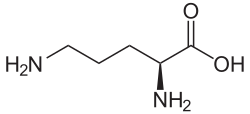Top Qs
Timeline
Chat
Perspective
Ornithine
Chemical compound From Wikipedia, the free encyclopedia
Remove ads
Ornithine is a non-proteinogenic α-amino acid that plays a role in the urea cycle. It is not incorporated into proteins during translation. Ornithine is abnormally accumulated in the body in ornithine transcarbamylase deficiency, a disorder of the urea cycle. The moiety derived from ornithine is called ornithyl.[2]
Remove ads
Role in urea cycle
Summarize
Perspective
L-Ornithine is one of the products of the action of the enzyme arginase on L-arginine, creating urea. Therefore, ornithine is a central component of the urea cycle, which enables the disposal of excess nitrogen. Ornithine itself is recycled and, in a sense, acts as a catalyst.
First, ammonia is converted into carbamoyl phosphate (H
2NC(O)OPO2−
3) by carbamoyl phosphate synthetase. Ornithine transcarbamylase then catalyzes the reaction between carbamoyl phosphate and ornithine to form citrulline and phosphate (Pi). Another amino group is contributed by aspartate, leading to the formation of arginine and the byproduct fumarate. The resulting arginine, a guanidinium compound, is subsequently hydrolyzed by arginase to regenerate ornithine and release urea.
The two nitrogen atoms in urea are derived from ammonia and aspartate, while the nitrogen atoms in ornithine remain unchanged.

Ornithine is not an amino acid directly coded for by DNA; that is, it is not a proteinogenic amino acid. However, in mammalian non-hepatic tissues, the primary role of the urea cycle is often the biosynthesis of arginine. As an intermediate in metabolic pathways, ornithine is thus quite important.[4]
Remove ads
Other reactions
Ornithine, through the action of ornithine decarboxylase (EC 4.1.1.17), serves as the starting point for the synthesis of polyamines such as putrescine.
In bacteria such as E. coli, ornithine can be synthesized from L-glutamate.[5]

Research
Exercise fatigue
L-Ornithine supplementation has been shown to attenuate fatigue in subjects in placebo-controlled studies using a cycle ergometer. The results suggest that L-ornithine may exert an antifatigue effect by increasing the efficiency of energy consumption and promoting the excretion of ammonia.[6][7]
Weightlifting supplement
Amino acid supplements, including L-ornithine, are frequently marketed to bodybuilders and weightlifters with claims of increasing levels of human growth hormone (HGH), muscle mass, and strength. A short, four-day clinical study conducted in 1993 reported that L-ornithine, in combination with L-arginine and L-lysine at 2 g/day each, did not increase HGH levels.[8] A review published in 2002 concluded, "The use of specific amino acids to stimulate GH release by athletes is not recommended."[9]
Cirrhosis
L-ornithine L-aspartate (LOLA), a stable salt of ornithine and aspartic acid, has been used in the treatment of cirrhosis[10] and hepatic encephalopathy.[11]
See also
References
External links
Wikiwand - on
Seamless Wikipedia browsing. On steroids.
Remove ads


